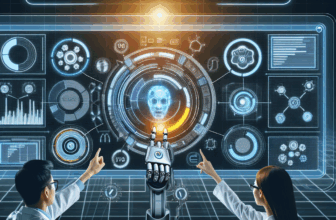Enhancing Customer Experience: The Benefits of AI-Driven Intelligent Chatbots
Table of Contents
- 1. Introduction
- 2. Understanding AI-Driven Intelligent Chatbots
- 3. Benefits of AI-Driven Chatbots
- 4. Real-World Examples and Case Studies
- 5. Challenges of Implementing Chatbots
- 6. Best Practices for Implementing Chatbots
- 7. Future Trends and Innovations
- 8. FAQ
1. Introduction
In today's digital age, businesses are striving to enhance the customer experience in unprecedented ways. With the rise of artificial intelligence (AI) and machine learning technologies, AI-driven intelligent chatbots have become integral tools for providing efficient customer service and engagement. This article explores the various aspects of AI-driven chatbots and how they enhance the customer experience, including their technologies, benefits, challenges, best practices, and future trends.
2. Understanding AI-Driven Intelligent Chatbots
2.1 Definition and Types of Chatbots
Chatbots are AI-powered applications designed to simulate human-like conversations. They can interact with users through natural language processing, enabling them to understand and respond to human language. There are two main types of chatbots: rule-based and AI-driven.
- Rule-Based Chatbots: These chatbots operate based on predefined rules and scripts. They are limited to structured conversations and are best for answering simple queries.
- AI-Driven Chatbots: These chatbots employ advanced algorithms and machine learning models to understand customer intents and provide contextual responses. They can learn from interactions to improve their responses over time.
2.2 The Technology Behind Chatbots
AI-driven chatbots utilize various technologies to function effectively. Key components include:
- Natural Language Processing (NLP): NLP enables chatbots to comprehend and interpret human language, allowing for more natural and fluid interactions.
- Machine Learning (ML): ML algorithms allow chatbots to learn from previous interactions and improve their performance by recognizing patterns in customer behavior.
- Deep Learning: A subset of ML that uses neural networks for more complex decision-making processes, enabling chatbots to understand sentiment and context better.
3. Benefits of AI-Driven Chatbots
3.1 24/7 Availability
One of the significant advantages of AI-driven chatbots is their ability to provide round-the-clock service. Unlike human agents, chatbots can engage with customers at any hour, tackling inquiries and support issues without interruption. This 24/7 availability leads to higher customer satisfaction rates, as customers no longer have to wait for business hours to receive the help they need.
Furthermore, the ability to provide instant responses enhances customer engagement, ensuring that users do not abandon their inquiries due to delays. In a world where instant gratification is expected, chatbots fulfill this need efficiently, providing immediate solutions and enhancing customer loyalty.
3.2 Increased Efficiency
AI-driven chatbots are designed to handle numerous queries simultaneously, which dramatically increases operational efficiency. This capability allows customer service teams to focus on more complex inquiries or tasks that require a human touch, rather than spending time on repetitive queries.
Businesses can scale their operations without necessarily expanding their workforce. By deploying chatbots, companies can maintain high service levels during peak times or crises when human agents might be overwhelmed, ensuring that customers receive timely assistance regardless of business conditions.
3.3 Personalization of Customer Experience
AI-driven chatbots can offer personalized interactions by utilizing data analytics to understand customer behavior and preferences. By analyzing past interactions, chatbots can provide tailored responses and recommend products or services that align with customer interests.
Personalization enhances the customer experience by making interactions feel more relevant and engaging. For example, if a customer frequently purchases a specific item, the chatbot can suggest similar products or remind them when it's time to replenish their stock. This level of customization not only improves satisfaction but also increases the likelihood of conversion and repeat transactions.
4. Real-World Examples and Case Studies
4.1 Case Study 1: Sephora's Virtual Artist
Sephora, a leading cosmetic retailer, employs an AI-driven chatbot named “Virtual Artist” to enhance customer engagement. This innovative chatbot allows users to try on makeup virtually by utilizing augmented reality and AI technology.
Customers can upload their photos and see how different products look on them in real time, creating a unique and interactive shopping experience. This application of AI-driven technology not only increases customer engagement but also helps reduce the uncertainty associated with buying cosmetics online, potentially lowering return rates and enhancing customer satisfaction.
4.2 Case Study 2: H&M's Virtual Shopping Assistant
H&M, the global fashion retailer, has developed a chatbot called “H&M Chatbot” that serves as a virtual shopping assistant. Built into their mobile app, this chatbot provides fashion advice, suggests outfits, and assists customers with purchase decisions.
By analyzing the customer’s preferences and past purchase history, the H&M chatbot can recommend clothes that match the customer's style. The AI-driven experience leads to increased customer engagement, driving sales and enhancing brand loyalty. Customers appreciate the personalized touch, which makes shopping more enjoyable and efficient.
5. Challenges of Implementing Chatbots
5.1 Technical Challenges
Despite their benefits, implementing AI-driven chatbots can come with various technical challenges. These challenges may include:
- Integration with Existing Systems: Businesses often have legacy systems and multiple platforms that must work seamlessly with the chatbot. Ensuring smooth integration can be complex and resource-intensive.
- Data Privacy and Compliance: Chatbots often handle sensitive customer data, raising concerns about privacy and compliance with data protection regulations.
- Quality of Responses: While AI-driven chatbots can learn and adapt, they can still struggle to provide accurate and contextually relevant responses, particularly in complex scenarios. Businesses must continually monitor and improve their chatbots.
5.2 Customer Acceptance Issues
Customer acceptance is another significant challenge in the adoption of AI-driven chatbots. Some customers may prefer human interaction, particularly for sensitive issues or complex inquiries. Building trust in chatbots and ensuring a seamless transition between chatbot interactions and human agents is crucial to mitigate frustration and ensure customer satisfaction.
Additionally, businesses need to provide clear communication on when customers will be interacting with a chatbot and what type of service they can expect. Effective training and communication can assist in overcoming these acceptance challenges and promote a more positive perception of chatbot interactions.
6. Best Practices for Implementing Chatbots
6.1 Clearly Defined Goals
For successful chatbot implementation, it is essential to establish clearly defined goals. Businesses should outline what they hope to achieve through the use of a chatbot—whether it’s improving customer service efficiency, increasing sales, or enhancing customer engagement.
Setting specific goals allows companies to measure the effectiveness of their chatbots and make necessary adjustments based on data and customer feedback. Regular evaluation against these goals can lead to continuous improvement in chatbot performance and customer satisfaction.
6.2 User-Friendly Design
A user-friendly design is crucial in ensuring the success of AI-driven chatbots. The chatbot’s interface should be intuitive and easy to navigate, allowing customers to interact effortlessly. Employing chat interfaces that mimic natural conversational patterns can significantly enhance user experience.
Additionally, providing fallback options, such as easily accessible human support, can help to manage customer expectations and make interactions smoother. Collecting feedback from users on chatbot experiences can also inform ongoing design improvements.
7. Future Trends and Innovations
7.1 Emerging Technologies in Chatbots
The future of chatbots lies in the integration of emerging technologies. Some trends are shaping the evolution of AI-driven chatbots:
- Voice Recognition: With the rise of voice-activated devices, chatbots are evolving to include voice interaction capabilities. This functionality could lead to a more natural and efficient user experience.
- Multilingual Support: As globalization continues, the demand for multilingual chatbots is growing. AI-driven chatbots that can communicate in various languages will enhance customer experiences across diverse markets.
- Enhanced Emotional Intelligence: Future chatbots may harness emotional AI to understand customer emotions and sentiments better, allowing for more empathetic interactions and improved customer satisfaction.
7.2 Predictive Analytics and Chatbots
Predictive analytics is another area set to redefine the chatbot landscape. By analyzing historical data, chatbots can anticipate customer questions and provide proactive support. This capability not only enhances customer service but also allows businesses to address customer issues before they escalate.
Implementing predictive analytics can lead to more targeted marketing strategies and personalized product recommendations, driving increased sales and engagement. As predictive technology improves, the effectiveness of chatbots will likely improve, positioning them as essential tools in customer engagement.
8. FAQ
Q: What are the main advantages of using chatbots for customer service?
A: The main advantages include 24/7 availability, increased efficiency, and the ability to offer personalized customer experiences. Chatbots can handle multiple queries simultaneously, improve response times, and enhance customer satisfaction.
Q: How do I know if a chatbot is suitable for my business?
A: Consider your customer service needs, volume of customer inquiries, and the complexity of issues you handle. If you frequently receive repetitive queries or low-complexity interactions, a chatbot might be a great fit.
Q: What are some common challenges businesses face when implementing chatbots?
A: Common challenges include technical integration with existing systems, data privacy concerns, quality of responses, and customer acceptance. Businesses should prepare to address these issues for successful implementation.
Resources
| Source | Description | Link |
|---|---|---|
| Forrester | Research on the impact of AI-driven customer service solutions. | https://go.forrester.com/ |
| McKinsey & Company | Insights on AI driving business innovation and customer experience. | https://www.mckinsey.com/ |
| Gartner | Overview of customer service and support analysis in AI. | https://www.gartner.com/en |
Conclusion
AI-driven intelligent chatbots present a tremendous opportunity for businesses to enhance their customer experience. The benefits of 24/7 availability, efficiency, and personalization are unequivocal, and the successful implementation of these solutions hinges on addressing potential challenges. As technology continues to evolve, businesses that adapt to these innovations will likely see increased loyalty and engagement from their customers.
Future advancements in chatbots, such as improved emotional intelligence and predictive analytics, promise to further shape the landscape of customer interaction. Understanding these trends will enable businesses to leverage AI-driven chatbots effectively, leading to more successful customer engagement strategies.
Disclaimer
This article is produced by A.I. and is in Beta Testing. The information presented is intended for informational purposes only and should not be construed as professional advice. Always consult professionals for specific inquiries or situations.










